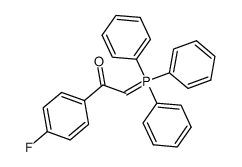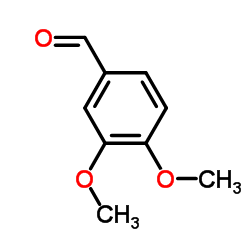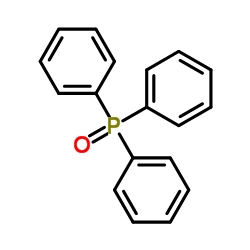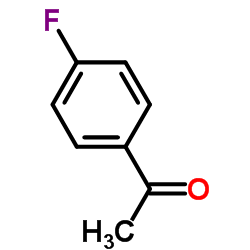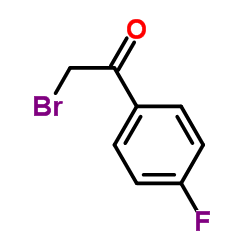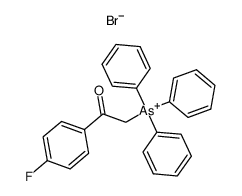2-Propen-1-one,3-(3,4-dimethoxyphenyl)-1-(4-fluorophenyl)-
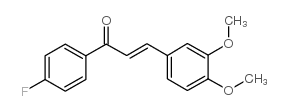
2-Propen-1-one,3-(3,4-dimethoxyphenyl)-1-(4-fluorophenyl)- structure
|
Common Name | 2-Propen-1-one,3-(3,4-dimethoxyphenyl)-1-(4-fluorophenyl)- | ||
|---|---|---|---|---|
| CAS Number | 28081-14-3 | Molecular Weight | 286.29800 | |
| Density | 1.182g/cm3 | Boiling Point | 92-94ºC | |
| Molecular Formula | C17H15FO3 | Melting Point | 90-93ºC(lit.) | |
| MSDS | USA | Flash Point | 207.2ºC | |
| Name | 3,4-dimethoxy-4'-fluorochalcone |
|---|---|
| Synonym | More Synonyms |
| Density | 1.182g/cm3 |
|---|---|
| Boiling Point | 92-94ºC |
| Melting Point | 90-93ºC(lit.) |
| Molecular Formula | C17H15FO3 |
| Molecular Weight | 286.29800 |
| Flash Point | 207.2ºC |
| Exact Mass | 286.10100 |
| PSA | 35.53000 |
| LogP | 3.73900 |
| Vapour Pressure | 1.18E-07mmHg at 25°C |
| Index of Refraction | 1.579 |
Synonym:1-(4-Fluorophenyl)-3-(3,4-dimethoxyphenyl)-2-propenone Section 2 - COMPOSITION, INFORMATION ON INGREDIENTS
Risk Phrases: 36/37/38 Section 3 - HAZARDS IDENTIFICATION EMERGENCY OVERVIEW
Irritating to eyes, respiratory system and skin.The toxicological properties of this material have not been fully investigated. Potential Health Effects Eye: Causes eye irritation. Skin: Causes skin irritation. May be harmful if absorbed through the skin. The toxicological properties of this material have not been fully investigated. Ingestion: May cause irritation of the digestive tract. The toxicological properties of this substance have not been fully investigated. May be harmful if swallowed. Inhalation: Causes respiratory tract irritation. The toxicological properties of this substance have not been fully investigated. May be harmful if inhaled. Chronic: No information found. Section 4 - FIRST AID MEASURES Eyes: In case of contact, immediately flush eyes with plenty of water for at least 15 minutes. Get medical aid. Skin: In case of contact, immediately flush skin with plenty of water. Remove contaminated clothing and shoes. Get medical aid. Wash clothing before reuse. Ingestion: If swallowed, do not induce vomiting unless directed to do so by medical personnel. Never give anything by mouth to an unconscious person. Get medical aid. Inhalation: If inhaled, remove to fresh air. If not breathing, give artificial respiration. If breathing is difficult, give oxygen. Get medical aid. Notes to Physician: Treat symptomatically and supportively. Section 5 - FIRE FIGHTING MEASURES General Information: As in any fire, wear a self-contained breathing apparatus in pressure-demand, MSHA/NIOSH (approved or equivalent), and full protective gear. This material in sufficient quantity and reduced particle size is capable of creating a dust explosion. Extinguishing Media: Use water spray, dry chemical, carbon dioxide, or chemical foam. Section 6 - ACCIDENTAL RELEASE MEASURES General Information: Use proper personal protective equipment as indicated in Section 8. Spills/Leaks: Vacuum or sweep up material and place into a suitable disposal container. Avoid generating dusty conditions. Provide ventilation. Section 7 - HANDLING and STORAGE Handling: Use with adequate ventilation. Minimize dust generation and accumulation. Avoid contact with skin and eyes. Avoid breathing dust. Storage: Store in a cool, dry place. Store in a tightly closed container. Section 8 - EXPOSURE CONTROLS, PERSONAL PROTECTION Engineering Controls: Facilities storing or utilizing this material should be equipped with an eyewash facility and a safety shower. Use adequate ventilation to keep airborne concentrations low. Exposure Limits CAS# 28081-14-3: Personal Protective Equipment Eyes: Wear appropriate protective eyeglasses or chemical safety goggles as described by OSHA's eye and face protection regulations in 29 CFR 1910.133 or European Standard EN166. Skin: Wear appropriate protective gloves to prevent skin exposure. Clothing: Wear appropriate protective clothing to prevent skin exposure. Respirators: Follow the OSHA respirator regulations found in 29 CFR 1910.134 or European Standard EN 149. Use a NIOSH/MSHA or European Standard EN 149 approved respirator if exposure limits are exceeded or if irritation or other symptoms are experienced. Section 9 - PHYSICAL AND CHEMICAL PROPERTIES Physical State: Crystalline powder Color: pale yellow Odor: Not available. pH: Not available. Vapor Pressure: Not available. Viscosity: Not available. Boiling Point: 92 - 94 deg C Freezing/Melting Point: 88 - 93 deg C Autoignition Temperature: Not available. Flash Point: Not applicable. Explosion Limits, lower: Not available. Explosion Limits, upper: Not available. Decomposition Temperature: Solubility in water: Insoluble. Specific Gravity/Density: Molecular Formula: C17H15FO3 Molecular Weight: 286.30 Section 10 - STABILITY AND REACTIVITY Chemical Stability: Stable under normal temperatures and pressures. Conditions to Avoid: Dust generation, heat. Incompatibilities with Other Materials: Strong oxidizing agents. Hazardous Decomposition Products: Carbon monoxide, carbon dioxide, hydrogen fluoride gas. Hazardous Polymerization: Will not occur. Section 11 - TOXICOLOGICAL INFORMATION RTECS#: CAS# 28081-14-3 unlisted. LD50/LC50: Not available. Carcinogenicity: 3,4-Dimethoxy-4'-fluorochalcone - Not listed by ACGIH, IARC, or NTP. Section 12 - ECOLOGICAL INFORMATION Section 13 - DISPOSAL CONSIDERATIONS Dispose of in a manner consistent with federal, state, and local regulations. Section 14 - TRANSPORT INFORMATION IATA Not regulated as a hazardous material. IMO Not regulated as a hazardous material. RID/ADR Not regulated as a hazardous material. Section 15 - REGULATORY INFORMATION European/International Regulations European Labeling in Accordance with EC Directives Hazard Symbols: XI Risk Phrases: R 36/37/38 Irritating to eyes, respiratory system and skin. Safety Phrases: S 26 In case of contact with eyes, rinse immediately with plenty of water and seek medical advice. S 37/39 Wear suitable gloves and eye/face protection. WGK (Water Danger/Protection) CAS# 28081-14-3: No information available. Canada None of the chemicals in this product are listed on the DSL/NDSL list. CAS# 28081-14-3 is not listed on Canada's Ingredient Disclosure List. US FEDERAL TSCA CAS# 28081-14-3 is not listed on the TSCA inventory. It is for research and development use only. SECTION 16 - ADDITIONAL INFORMATION N/A |
| Personal Protective Equipment | Eyeshields;Gloves;type N95 (US);type P1 (EN143) respirator filter |
|---|---|
| Hazard Codes | Xi: Irritant; |
| Risk Phrases | 36/37/38 |
| Safety Phrases | 37/39-26 |
| RIDADR | NONH for all modes of transport |
| HS Code | 2914700090 |
|
~73% 
2-Propen-1-one,... CAS#:28081-14-3 |
| Literature: Bansal, R. K.; Mathur, Suchitra; Jain, Jainendra K.; Sharma, Diwakar Journal of the Indian Chemical Society, 1988 , vol. 65, p. 134 - 136 |
|
~% 
2-Propen-1-one,... CAS#:28081-14-3 |
| Literature: Cardia, Maria Cristina; Sanna, Maria Luisa; Meleddu, Rita; Distinto, Simona; Yanez, Matilde; Vina, Dolores; Lamela, Manuel; Maccioni, Elias Journal of Heterocyclic Chemistry, 2013 , vol. 50, # SUPPL.1 p. E87-E92 |
|
~66% 
2-Propen-1-one,... CAS#:28081-14-3 |
| Literature: Bansal, Raj K.; Bhagchandani, Gope Journal fuer Praktische Chemie (Leipzig), 1981 , vol. 323, # 1 p. 49 - 54 |
|
~% 
2-Propen-1-one,... CAS#:28081-14-3 |
| Literature: Bansal, Raj K.; Bhagchandani, Gope Journal fuer Praktische Chemie (Leipzig), 1981 , vol. 323, # 1 p. 49 - 54 |
|
~% 
2-Propen-1-one,... CAS#:28081-14-3 |
| Literature: Bansal, Raj K.; Bhagchandani, Gope Journal fuer Praktische Chemie (Leipzig), 1981 , vol. 323, # 1 p. 49 - 54 |
| HS Code | 2914700090 |
|---|---|
| Summary | HS: 2914700090 halogenated, sulphonated, nitrated or nitrosated derivatives of ketones and quinones, whether or not with other oxygen function Tax rebate rate:9.0% Supervision conditions:none VAT:17.0% MFN tariff:5.5% General tariff:30.0% |
| MFCD01901414 |
